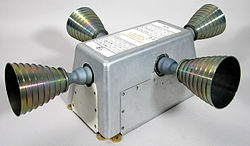R-4D
 RCS quad containing four R-4D thrusters, as used on the Apollo Service Module | |
| Country of origin | United States |
|---|---|
| Manufacturer | Kaiser Marquardt Aerojet Rocketdyne |
| Application | Reaction control system |
| Liquid-fuel engine | |
| Propellant | NTO/MMH |
| Cycle | Pressure-fed |
| Performance | |
| Thrust, vacuum | 110 pounds-force (490 N) |
| Thrust-to-weight ratio | 13.74 |
| Chamberpressure | 100.5 pounds per square inch (6.93 bar) |
| Specific impulse,vacuum | 312 s |
| Dimensions | |
| Length | 12.00 inches (30.5 cm) |
| Diameter | 6.00 inches (15.2 cm) |
| Dry mass | 8.00 pounds (3.63 kg) |
| Used in | |
| Orion (spacecraft) H-II Transfer Vehicle(1, 2, 4) Space Shuttle Apollo (spacecraft) Cassini (spacecraft) ESAAutomated Transfer Vehicle | |
TheR-4Dis a smallhypergolicrocket engine,originally designed byMarquardt Corporationfor use as areaction control systemthruster on vehicles of theApollo crewed Moon landing program.Aerojet Rocketdynemanufactures and markets modern versions of the R-4D.[1]
History[edit]
Developed as an attitude control thruster for the ApolloCommand/Service ModuleandLunar Modulein the 1960s, each unit for the modules employed four quadruple clusters (pods). It was first flown onAS-201in February 1966. Approximately 800 were produced during the Apollo program.[2]
Post-Apollo, modernized versions of the R-4D have been used in a variety of spacecraft, including theU.S. Navy'sLeasat,Insat 1,Intelsat 6,Italsat,andBulgariaSat-1.[3]It has also been used onJapan'sH-II Transfer Vehicleand theEuropeanAutomated Transfer Vehicle,both of which delivered cargo to theInternational Space Station.[4]It is also used on theOrion spacecraft.[5]
Design[edit]
The R-4D is a fuel-film cooled engine. Some of the fuel is injected longitudinally down the combustion chamber, where it forms a cooling film.[6]
The thruster's design has changed several times since its introduction. The original R-4D's combustion chamber was formed from analloyofmolybdenum,coated in a layer ofdisilicide.[2]Later versions[clarification needed][when?]switched to aniobiumalloy, for its greater ductility. Beginning with the R-4D-14,[when?]the design was changed again to use aniridium-linedrheniumcombustion chamber, which provided greater resistance to high-temperature oxidization and promoted mi xing of partially reacted gasses.[6]
The R-4D requires no igniter as it uses hypergolic fuel.
It is rated for up to one hour of continuous thrust, 40,000 seconds total, and 20,000 individual firings.[6][7]
Additional literature[edit]
References[edit]
- ^"Bipropellant Rocket Engines".Aerojet Rocketdyne.Retrieved7 May2014.
- ^abDavid Meerman Scott (November 2013)."Marquardt R-4D Apollo spacecraft attitude control engine".Apollo Artifacts.Retrieved5 February2016.
- ^"BulgariaSat-1".spaceflight101.Retrieved23 June2017.
- ^Stechman, Carl; Harper, Steve (July 2010).Performance Improvements in Small Earth Storable Rocket Engines.46th AIAA/ASME/SAE/ASEE Joint Propulsion Conference. AIAA.doi:10.2514/6.2010-6884.
Derivates of this engine are still used today on satellites and spacecraft including the European autonomous transfer vehicle (ATV) and the Japanese H-2 transfer vehicle (HTV) propulsion systems and the future Orion service module.
- ^"Artemis 1".
- ^abcStechman, Carl; Harper, Steve (2010).Performance Improvements in Small Earth Storable Rocket Engines- An Era of Approaching the Theoretical.46th AIAA/ASME/SAE/ASEE Joint Propulsion Conference. The American Institute of Aeronautics and Astronautics.doi:10.2514/6.2010-6884.ISBN978-1-60086-958-7.S2CID111626089.
- ^"R-4D".Astronautix. Archived fromthe originalon August 26, 2002.Retrieved5 February2016.

